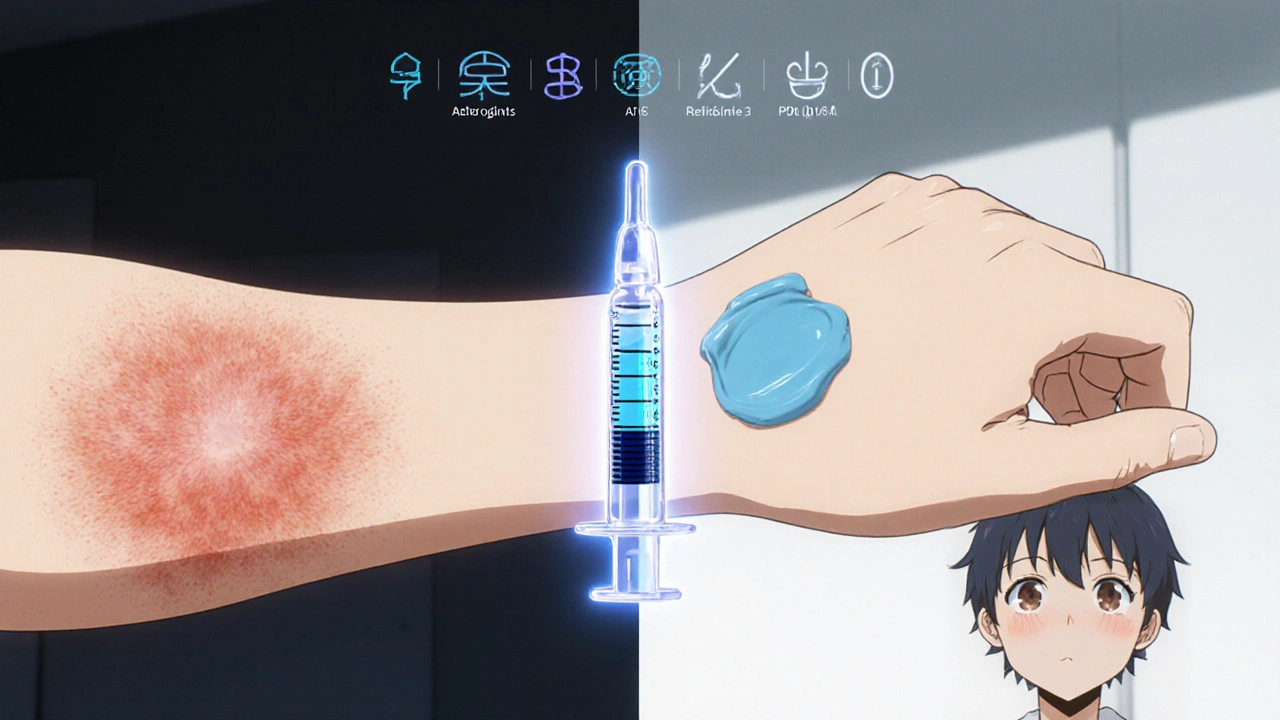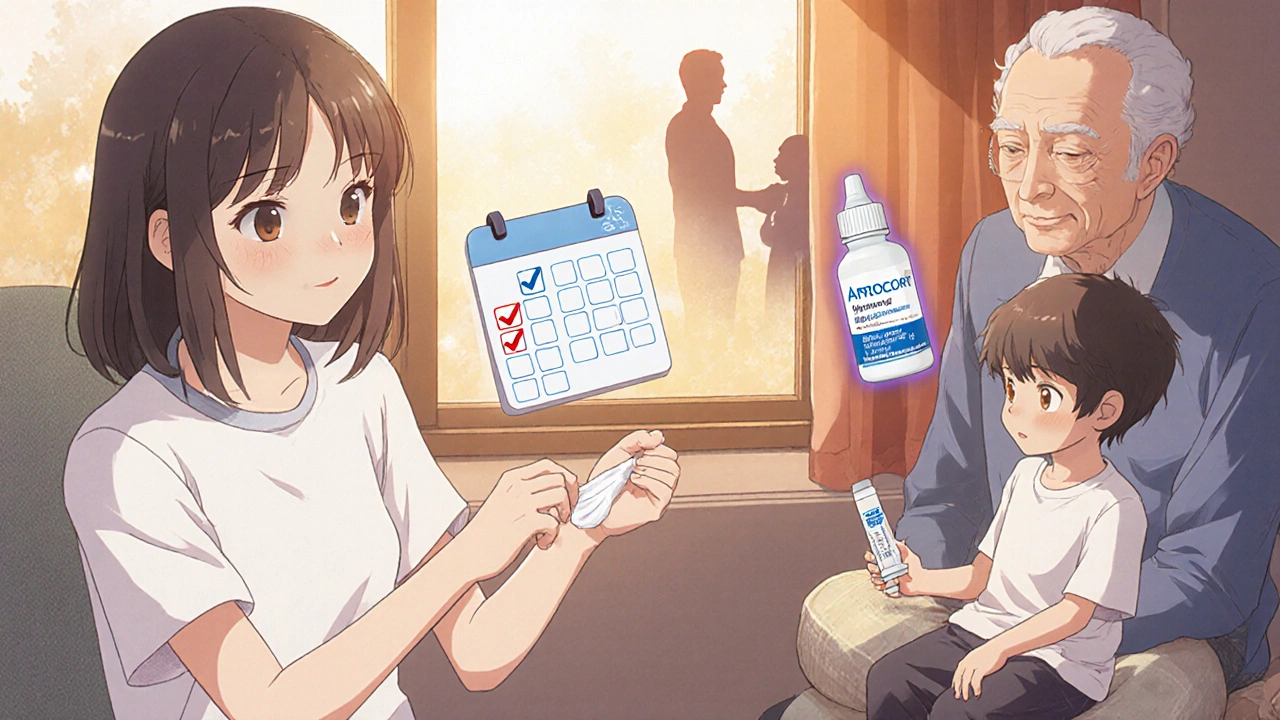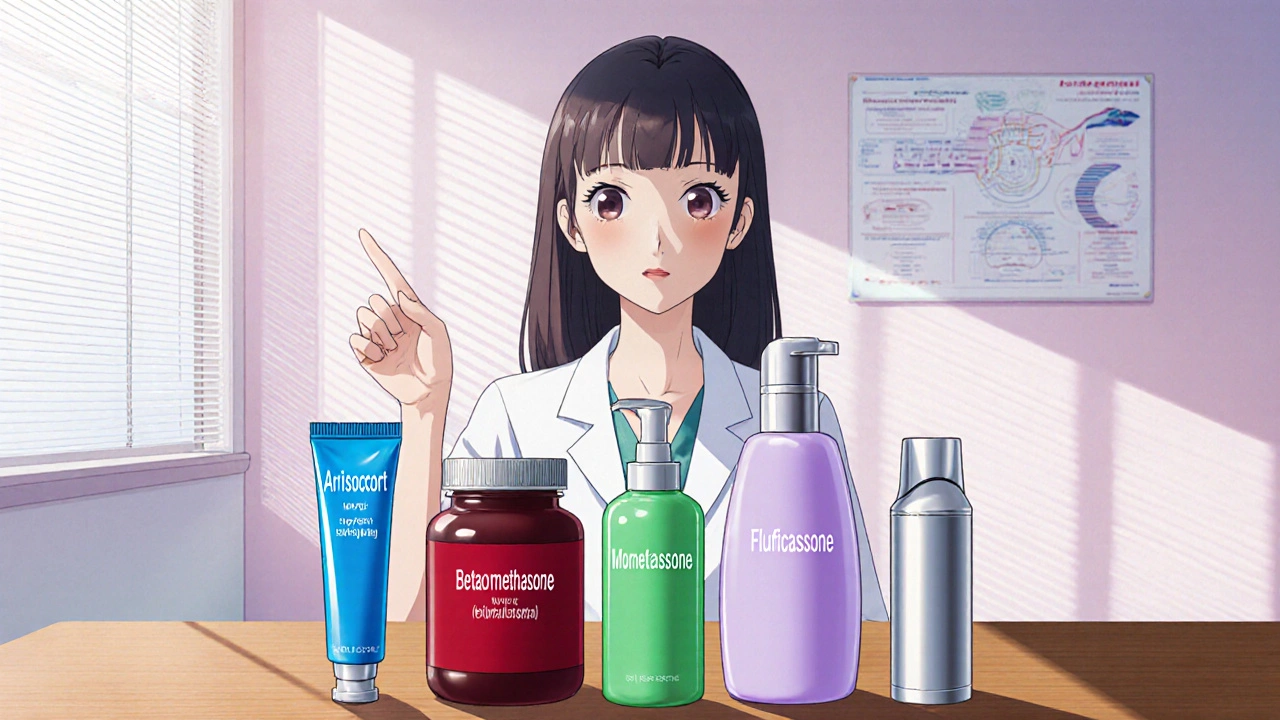Steroid Selection Calculator
This calculator helps identify the most appropriate corticosteroid for your condition based on severity, location, and treatment duration. Remember to always consult your doctor for personalized medical advice.
When a doctor prescribes a corticosteroid, patients often wonder how Aristocort (triamcinolone acetonide) compares with the other steroids on the market. The answer isn’t a one‑size‑fits‑all; it depends on potency, formulation, the skin condition you’re treating, and how the drug is delivered. This guide walks you through the most common alternatives, highlights key differences, and gives you practical tips for choosing the right option for your situation.
Why the comparison matters
Topical and injectable steroids vary dramatically in strength. Using a steroid that’s too weak may leave a rash unchanged, while a drug that’s too strong can cause thinning skin, hormonal imbalance, or other side effects. By understanding the trade‑offs, you can work with your clinician to match the drug’s potency to the severity of the condition, reducing risk and speeding recovery.
Understanding corticosteroid basics
Corticosteroids are a class of hormones that reduce inflammation by dampening the immune response. They are categorized by:
- Potency - how strong the anti‑inflammatory effect is.
- Formulation - cream, ointment, spray, inhaler, or injection.
- Absorption - how much of the drug reaches the bloodstream.
For skin conditions, potency is the most relevant factor, and it’s usually expressed on a scale from low (e.g., hydrocortisone 1%) to very high (e.g., clobetasol propionate 0.05%).
Core alternatives to Aristocort
Below are the most frequently used corticosteroids that clinicians consider alongside triamcinolone. Each entry includes a brief definition with Betamethasone, Hydrocortisone, Mometasone, Fluticasone, and Prednisone. Their typical uses range from mild eczema to severe psoriasis.
Side‑effect profile at a glance
All steroids carry a risk of side effects, but the likelihood and severity differ. Common concerns include skin atrophy, stretch marks, telangiectasia, and systemic effects like adrenal suppression when large areas are treated or the drug is used for prolonged periods.
| Drug | Potency (US ranking) | Common Forms | Typical Indications | Onset of Action | Key Side‑effects |
|---|---|---|---|---|---|
| Aristocort (Triamcinolone) | Medium‑high (Class III-IV) | Cream, ointment, spray, intralesional injection | Eczema, psoriasis, allergic dermatitis, keloids | 2-3 days | Skin thinning, possible HPA axis suppression with extensive use |
| Betamethasone | High (Class IV) | Cream, ointment, lotion | Severe eczema, lichen planus, discoid lupus | 1-2 days | Higher risk of atrophy, telangiectasia |
| Hydrocortisone | Low (Class I) | Cream, ointment, lotion | Mild dermatitis, insect bites, diaper rash | 3-5 days | Minimal systemic absorption, rare atrophy |
| Mometasone | Medium (Class III) | Cream, ointment, lotion, spray | Psoriasis, eczema, allergic rhinitis (nasal spray) | 2 days | Low to moderate skin thinning, safe for face |
| Fluticasone | Medium (Class III) - primarily inhaled/oral | Inhaler, nasal spray, topical cream (limited) | Asthma, allergic rhinitis, localized skin inflammation | 1 day (inhaled), 2-3 days (topical) | Oropharyngeal candidiasis (inhaled), local irritation |
| Prednisone | Systemic high potency (oral) | Tablet, liquid | Severe systemic inflammation, autoimmune diseases | Hours (systemic) | Weight gain, glucose intolerance, mood changes, osteoporosis |
How to choose the right steroid for you
Consider these three decision points when discussing options with your doctor:
- Severity of the condition: Mild eczema usually responds well to low‑potency hydrocortisone, while stubborn psoriasis may need a medium‑high option like Aristocort or betamethasone.
- Location on the body: Sensitive areas (face, folds) benefit from lower‑potency or newer‑generation steroids such as mometasone, which cause less atrophy.
- Duration of therapy: For short bursts (under two weeks), a higher‑potency steroid can be safe. For chronic use, rotating potencies or using intermittent “weekends off” can mitigate side effects.
Ask your clinician about a potency ladder - a step‑up or step‑down plan that lets you start strong, then taper to a milder drug as the skin improves.

Practical tips for safe use
- Apply a thin layer - more isn’t better.
- Wash hands before and after application.
- Avoid covering treated areas with occlusive dressings unless instructed.
- Monitor for signs of thinning skin: easy bruising, visible blood vessels.
- Schedule regular follow‑ups to reassess potency needs.
When using injectable triamcinolone (often for keloids or joint inflammation), the doctor will calculate dose based on body weight and lesion size. Over‑injection can cause localized atrophy, so precise technique matters.
Special populations
Pregnant or breastfeeding patients: Most topical steroids, including triamcinolone, are considered low risk when used sparingly on limited areas. Systemic steroids like prednisone require careful risk‑benefit analysis.
Children: Pediatric skin is more permeable, so lower‑potency options (hydrocortisone, mild mometasone) are preferred for eczema. If a higher‑potency drug is needed, doctors often limit the treatment period to under two weeks.
Elderly: Thinner skin increases the chance of atrophy. Starting with a low‑potency steroid and evaluating response before escalation is the safest route.
Cost and accessibility considerations
In Australia, most common topical steroids are listed on the PBS (Pharmaceutical Benefits Scheme). Aristocort is generally subsidized for dermatological prescriptions, while some newer branded formulations of mometasone may require a co‑payment. Generic betamethasone and hydrocortisone are usually cheaper but may not be covered for certain indications.
Online pharmacies often ship these medicines, but be cautious of non‑regulated sellers. Always verify that the product is Australian‑registered and that a qualified prescriber has approved it.
Bottom line
There’s no single “best” steroid; the optimal choice balances potency, formulation, location, and treatment length. Aristocort comparison shows that triamcinolone sits in the medium‑high potency range, making it a solid middle ground for moderate to severe dermatitis when a stronger option like betamethasone isn’t necessary. Pair this knowledge with your dermatologist’s guidance, and you’ll reduce flare‑ups while keeping side‑effects in check.

Is Aristocort safe for long‑term use?
Aristocort can be used safely for several weeks on limited skin areas, but prolonged treatment (months) raises the risk of skin thinning and HPA‑axis suppression. Doctors usually prescribe a “step‑down” plan - start with triamcinolone, then switch to a lower‑potency steroid once the lesion improves.
How does triamcinolone compare to betamethasone in terms of potency?
Betamethasone is classified as a high‑potency (Class IV) steroid, whereas triamcinolone sits at medium‑high (Class III-IV). In practice, betamethasone works faster and is stronger, making it suitable for very thick plaques, while triamcinolone offers a slightly gentler profile ideal for large‑area treatment.
Can I use Aristocort on my face?
Facial skin is delicate, so many dermatologists favor low‑to‑medium potency steroids like mometasone or low‑dose triamcinolone for short periods. If a doctor prescribes Aristocort for a facial lesion, it’s usually for a limited time (under two weeks) and in a thin layer.
What are the main side‑effects of topical steroids?
Common side‑effects include skin atrophy, stretch marks, telangiectasia, and occasional acne‑like eruptions. Systemic absorption can suppress adrenal function when large areas are treated or when high‑potency steroids are used for weeks.
Is there a generic version of Aristocort?
Yes. In Australia, generic triamcinolone acetonide creams are available and are PBS‑subsidized. Brands may differ in base (cream vs ointment) but contain the same active ingredient.

